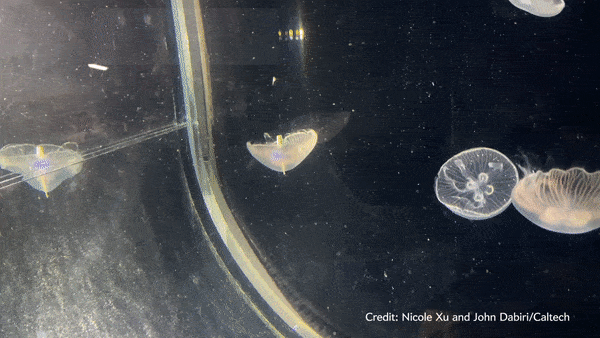Despite science’s best efforts to explore the ocean, the vast bulk of its depths remains unseen. The seas add up to more than 1.3 billion cubic kilometers—enough to fill a sphere one tenth as wide as the earth—and expensive tools such as depth-defying submarines and swimming drones would have to hit the waves in huge numbers to cover even a fraction of that water. But living creatures such as moon jellyfish already pervade the oceans, and now researchers at the California Institute of Technology and Stanford University are trying to turn these flimsy organisms into controllable cyborgs.
The scientists built a microelectronic “prosthesis” or “swim controller” from off-the-shelf parts. They fastened it to the underside of a saucer-size moon jellyfish with a short wooden pin, then ran two electrodes from the device to the sides of the creature’s bell. When active, the prosthesis stimulated the jellyfish’s muscles with a regular electronic pulse. To minimize the impact on the animal, the researchers fit the electronics inside a two-centimeter-wide cylindrical case, adding cork floats and stainless-steel weights to keep the system neutrally buoyant. The scientists tested the device on six moon jellyfish in a tank and found it could make the animals swim at nearly three times their natural pace. They maintained their typical speed when wearing an inactive swim controller. The results were published in Science Advances on Wednesday.
Although the device only affected the jellyfish’s speed, the researchers plan to add steering and sensing abilities to later versions. “With some relatively simple modifications, we think it’s possible to get this to be able to be steered—so to tell your animal, ‘Take a left turn here, take a 30-degree turn there, make a U-turn at this other location,’” says study co-author John Dabiri, a mechanical engineer at Caltech. Once they have made that modification, Dabiri and his co-author Nicole W. Xu, a bioengineering Ph.D. candidate at Stanford University, could add sensors to the device. “Ultimately,” Dabiri says, “the idea is that as [the jellyfish] are on that path, they would record the ocean temperature, salinity, pH—all of the variables that we’re concerned about when we try to quantify current and future ocean health and climate change.” He adds that researchers might one day be able to use such cyborgs to map an area, for example, collecting data until their swim controllers made them return to the surface.
“Data on the ocean is incredibly useful for a lot of applications,” says Elliott Hazen, an ecologist at the National Oceanic and Atmospheric Administration’s Marine Fisheries Service, who was not involved in the new study. “Understanding patterns in the ocean can help us improve our ability to predict the weather. At the same time, we use ocean measurements all the time to help direct marine activities—this could be things like telling fishermen where they’re more likely to encounter species of concern so they can reduce bycatch.”

Turning animals into living sensors obviously raises ethical questions. Dabiri notes, however, that moon jellyfish lack a brain, a central nervous system and the type of pain receptors that would make a mammal, for example, react to having a wooden pin thrust through its body tissues. This species has been known to produce mucus when stressed, but the researchers say they monitored their subjects and found no sign of this response. They also say the jellyfish healed within days and returned to functioning as usual after the experiment ended and the prosthesis was removed. If cyborg jellyfish were deployed as ocean monitors, Dabiri thinks they could live relatively normal lives. “We might be interested in a scenario in which the device is embedded for years at a time, collecting data,” he says. After that, “it might be released from the animal and returned to the surface, where the data can then be read out.”
As living sensors, bionic jellyfish would have several advantages over marine robots. First, they can survive for years, powering themselves by eating. The prosthesis itself requires a battery, but because its task is merely stimulating electrodes and not powering a motor, future versions could be tiny—the researchers claim that an “enhanced” jellyfish in the experiment proved 10 to 1,000 times more energy-efficient than existing swimming robots. Moving at the speedier pace did force the jellyfish to expend twice as much energy as usual, but this figure was actually lower than the researchers had expected: they initially thought increasing the speed by three times might require nine times more energy. “They’re more efficient at those faster speeds. They do consume more energy—but not as much as you might expect for the added amount of performance,” Dabiri says. “As far as we understand, they’re the most energy-efficient swimming animals in the world.” When jellyfish flex their blobby bodies, he explains, they change the water pressure around them in a way that boosts their forward motion without requiring a lot of additional energy expenditure.

Another plus is that moon jellyfish already live throughout the earth’s oceans, at a variety of temperatures and depths. The electronic prosthesis would be vulnerable in deep areas, but Dabiri says that it is easier to strengthen that small component than to build a depth-proof machine with moving parts.
“With inputs like climate change, we’re seeing new ocean states and new ecosystem responses to changes in our environment,” Hazen says. “We’re entering a realm where we need to rely more and more on animals to tell us where important places in the ocean are. And so the more we can outfit species—particularly species that aren’t threatened, like jellyfish—to understand our ocean environment, the better prepared we will be for future change and corresponding threats.”
“The idea here is to replace the small number of very expensive platforms that have really dominated ocean science for the past several decades with the idea of very low-cost, but very large in number, deployments of these types of bionic—if you will—jellyfish,” Dabiri says.


